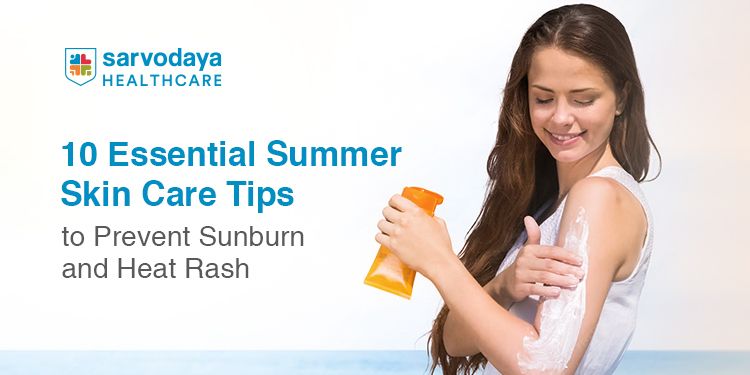Indian summers can be unforgiving, especially on your skin. Prolonged exposure to the sun, combined with heat and humidity, can lead to sunburn, heat rashes, tanning, and even dehydration. For many, these issues worsen due to poor skin care habits or a lack of awareness about how to protect the skin during the hottest months of the year.
Read along for 10 tried-and-tested tips to keep your skin healthy, hydrated, and protected all season long.1. Wear Sunscreen Daily – Not Just at the Beach
Sunscreen isn’t just for vacations. Applying a broad-spectrum sunscreen with SPF 30 or higher every day is one of the most important things you can do to protect your skin from UV damage, which is the primary cause of sunburn, pigmentation, and even premature ageing.
Make sure to:
- Apply sunscreen 15–30 minutes before stepping out.
- Reapply every 2–3 hours, especially if you're sweating or swimming.
- Use a lightweight, non-greasy formula suitable for your skin type.
Using sunscreen consistently can prevent over 80% of sun-related skin issues in the long run. Even on cloudy days or indoors (where UVA rays can penetrate windows), don’t skip it.
2. Stay Hydrated – Inside and Out
Dehydration isn’t just a threat to your body—it affects your skin too. Summer heat leads to increased sweating, which can strip your skin of essential moisture. To combat this:
- Ensure that you are drinking at least 8–10 glasses of water daily.
- Consume foods rich in water, like cucumbers, watermelon, and coconut water.
- Use water-based moisturisers and hydrating face mists throughout the day.
Maintaining moisture balance can help your skin heal faster, improving its elasticity and reducing sensitivity to heat rash and sunburn.
3. Choose Breathable, Cotton Clothing
What you wear in summer directly impacts your skin’s health. Tight, synthetic clothes can trap heat and sweat, leading to friction, clogged pores, and heat rashes—especially around the neck, chest, and back.
Instead, opt for:
- Loose-fitting cotton or linen fabrics
- Light colours that reflect heat
- Clothes that allow your skin to breathe freely
Breathable fabrics act as a first line of defence against both heat rashes and bacterial skin infections that flare up during summer.
4. Shower Right After Sweating
After a workout, a long walk, or even a short trip outdoors, it’s important to shower promptly. Sweat mixed with dust and pollutants can block your pores, causing irritation, acne, and even fungal infections.
Here’s how to do it right:
- Use mild, sulphate-free cleansers that don’t strip natural oils.
- Instead of rubbing your skin dry, pat it down gently.
- Avoid using excessively hot water.
Timely showers reduce your chances of developing heat-related skin issues and maintain your skin’s natural protective barrier.
5. Never Skip Moisturiser
Many people assume that moisturisers are only for winter, but summer dehydration can leave your skin feeling just as dry and tight, especially after sun exposure. The key is to switch to lightweight, water-based moisturisers that hydrate without clogging pores.
Look for:
- Gel-based or non-comedogenic formulas
- Moisturisers with relief ingredients like hyaluronic acid, glycerin or aloe vera
- Moisturisers with SPF for added protection during the day
Moisturise twice daily to prevent peeling and sensitivity and to help the skin recover faster from mild sunburns or irritation.
6. Avoid Peak Sun Hours (11 AM – 4 PM)
UV radiation is at its strongest during midday. Being outside between 11 AM and 4 PM increases your risk of sunburn, pigmentation, and long-term skin damage. If possible, plan outdoor tasks for early morning or late evening.
If stepping out is unavoidable:
- Use umbrellas or wide-brimmed hats.
- Wear UV-protective sunglasses and long-sleeved clothing.
- Reapply sunscreen more frequently.
Minimise direct sun exposure during these hours to prevent photoaging and reduce your risk of heat rashes, especially in children and older adults.
7. Apply Aloe Vera or Calamine for Soothing Relief
Even with precautions, minor sunburns and heat rashes can still occur. That’s where soothing agents like aloe vera or calamine lotion come in. These help cool the skin, reduce inflammation, and support faster healing.
You can:
- Extract aloe vera gel directly from the plant and apply it fresh.
- Use calamine lotion to ease itching and redness.
- Keep the products stored in the fridge for an extra cooling effect when you apply it.
Such gentle, accessible remedies for mild summer skin irritations can be very helpful, especially when you want quick relief without side effects.
8. Don’t Ignore Heat Rash Symptoms
Heat rash is also known as prickly heat and is caused by blocked sweat ducts. It appears as tiny red bumps, often accompanied by stinging or itching. While it may seem harmless at first, scratching or ignoring it can lead to skin infections.
Here’s what to do:
- Keep the area clean and dry.
- Don’t use thick creams or powders as they trap heat.
- Stick to wearing loose clothes and stay in cool environments.
If the rash persists or worsens, consult the best dermatologists in Delhi NCR for prompt treatment. Delaying care can lead to secondary infections, especially in high-friction zones like the neck, underarms, or thighs.
9. Exfoliate Gently, But Regularly
Due to sweat, oil and dust, dead skin cells build up faster in the summer. Regular exfoliation helps unclog pores, reduces tanning, and allows better absorption of moisturisers and serums. Ensure that you don’t overdo it, though, as it may irritate sun-exposed skin.
Stick to:
- Once or twice a week exfoliation
- Mild scrubs or chemical exfoliants like AHAs/BHAs
- Avoid exfoliating right after sun exposure.
Use exfoliants carefully, especially for sensitive or acne-prone skin. Always follow with a calming moisturiser or gel.
10. Consult a Skin Expert Before Problems Escalate
Sunburn, pigmentation, and heat rashes are common, but they shouldn’t be ignored if they persist or cause discomfort. Delayed care can result in dark spots, infections, or worsening of pre-existing conditions like eczema or acne.
When in doubt, seek a consultation at the best skin care hospital in Faridabad, Delhi NCR, for complete diagnostics and follow-ups.
Early intervention is key. A preventive consultation can also help identify your skin type and curate a regimen that truly works for you.
Conclusion
Taking care of your skin in summer doesn’t have to be complicated. With these 10 expert-backed tips, you can enjoy the sunny season without compromising on your skin’s health. From choosing the right sunscreen and clothes to knowing when to seek medical help, a little awareness goes a long way in preventing sunburns and heat rashes.
If you're struggling with summer skin issues or simply want a personalised skin care plan, the experts at Sarvodaya Hospital, Faridabad, are here to help. As the best skin care hospital in Faridabad, Delhi NCR, Sarvodaya offers access to the best dermatologists in Faridabad who make use of state-of-the-art diagnostics and safe treatment protocols tailored for Indian skin types. Whether it's preventive consultation or targeted treatment, your skin will be in expert hands.
Stay hydrated, stay protected—and don’t forget that your skin reflects your overall health. Your skin deserves the extra care in summer to keep it bright, radiant and cool.



















